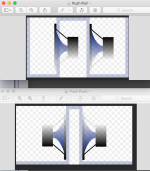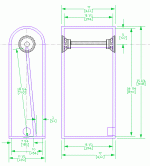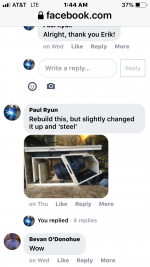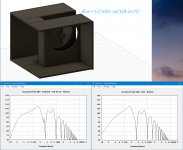This seems fairly basic/fundamental, but I cannot find a definition
of "push-push" for two drivers. I read what seems like mis-used or
perhaps contradictory or unclear usage of this term.
Does "push-push" strictly refer to two drivers mounted with opposite
direction of cone motion, without ANY mention of:
1.) wiring polarity
2.) shared air volume
3.) firing direction (although I presume it means "facing opposite directions")
4.) Isobaric or not
So what is the definition ?
Does it ONLY refer to force-cancellation for purposes of controlling
cabinet vibration ?
of "push-push" for two drivers. I read what seems like mis-used or
perhaps contradictory or unclear usage of this term.
Does "push-push" strictly refer to two drivers mounted with opposite
direction of cone motion, without ANY mention of:
1.) wiring polarity
2.) shared air volume
3.) firing direction (although I presume it means "facing opposite directions")
4.) Isobaric or not
So what is the definition ?
Does it ONLY refer to force-cancellation for purposes of controlling
cabinet vibration ?
I would say so, yes.
It's sometimes also used with slot loading in an open baffle to lower resonance and increase velocity, although you don't need two drivers to achieve that, so fundamentally it's only about force cancellation.
It's got nothing to do with isobaric speakers.
It's sometimes also used with slot loading in an open baffle to lower resonance and increase velocity, although you don't need two drivers to achieve that, so fundamentally it's only about force cancellation.
It's got nothing to do with isobaric speakers.
Last edited:
Push-push has a pair of drivers mounted in a box such that their acoustic output sums (ie in acoustic phase), but are physically opposed and tightly coupled such that the mechanical output of each driver is out of phase with th eother and the reactive forces are (largely) actively cancelled out leading to dramatically less load on the box panels. So one can use an elegant solution with light, stiff wood (we used 15mm BB), or brute force (not push-push) to attempt to achieve a noisless cabinet.
A basic ilustration (does not show the tight coupling).

This ancient thot experiment takes a pair of woofers designed to be bolted thru the pole piece of the driver to the cabinet and uses that to bolt the backs of the drivers together and the common ready-rod bolts tie the front together.
An over the top solution. Not unique thou.
toobz woofer

dave
A basic ilustration (does not show the tight coupling).

This ancient thot experiment takes a pair of woofers designed to be bolted thru the pole piece of the driver to the cabinet and uses that to bolt the backs of the drivers together and the common ready-rod bolts tie the front together.
An over the top solution. Not unique thou.
toobz woofer

dave
1) Polarity has four options, depending on what outcome is desired.Does "push-push" strictly refer to two drivers mounted with opposite
direction of cone motion, without ANY mention of:
1.) wiring polarity
2.) shared air volume
3.) firing direction (although I presume it means "facing opposite directions")
4.) Isobaric or not
So what is the definition ?
Does it ONLY refer to force-cancellation for purposes of controlling
cabinet vibration ?
2) Shared air volume may be enclosed or not.
3) "Push Pull" drivers point opposite directions.
4) Isobaric drivers share an enclosed air volume, and are wired so both cones move the same direction with positive voltage applied. If the Isobaric drivers are arranged as in the "Push Pull" example below, the drivers would be wired + to +, and - to -. The "Push Push" isobaric arrangement would use one driver reversed, and usually done as a "clamshell" arrangement with a minimum of enclosed volume, drivers bolted together on one baffle. Since the isobaric arrangements are wired so both cones move the same direction with positive voltage applied, they offer no force cancellation.
The typical use of the terms "Push Pull" and "Push Push" is for drivers sharing a volume of air that is not enclosed, the "slot" or "plenum" or "V" shape between the two cones exits to the outside of the cabinet or in to a horn or "pipe", and the drivers are wired so positive polarity results in an inward motion to both cones, requiring a polarity reverse of one driver in the "Push Pull" arrangement.
Either of those arrangements offer the same force cancellation, while "Push Pull" will reduce even order harmonic distortion of drivers with non-symmetric suspension or magnet force.
"Push pull" requires a larger plenum, and may also expose heat circulation vents on the back side of one of the drivers to the outside of the cabinet- the noise from those vents may be more objectionable than even order harmonic distortion reduction.
Planet10's dual driver examples in post #3 would be better described as "horizontally opposed", perhaps using "push pull horizontally opposed" if one driver's magnet would be reversed direction, which would require reversing it's polarity for an acoustic output summation.
Art
Attachments
Last edited:
What options, if any, are preferred with the two volumes created? all vented and motor sides to heavily stuffed TL or less stuffed via final tuning/preference seem plausible if say...
4of these? In a little 2.1 as the 0.1??
Peerless by Tymphany SDS-160F25PR01-08 6-1/2" Paper Cone Woofer Speaker
4of these? In a little 2.1 as the 0.1??
Peerless by Tymphany SDS-160F25PR01-08 6-1/2" Paper Cone Woofer Speaker
4) Isobaric drivers share an enclosed air volume, and are wired so both cones move the same direction with positive voltage applied. If the Isobaric drivers are arranged as in the "Push Pull" example below, the drivers would be wired + to +, and - to -. The "Push Push" isobaric arrangement would use one driver reversed, and usually done as a "clamshell" arrangement with a minimum of enclosed volume, drivers bolted together on one baffle. Since the isobaric arrangements are wired so both cones move the same direction with positive voltage applied, they offer no force cancellation.
While it is possible to do an isobarik push-push it is not, as i believe you are imagining, at all simple. The complexity/overhead becomes so large it just becomes not worthwhile
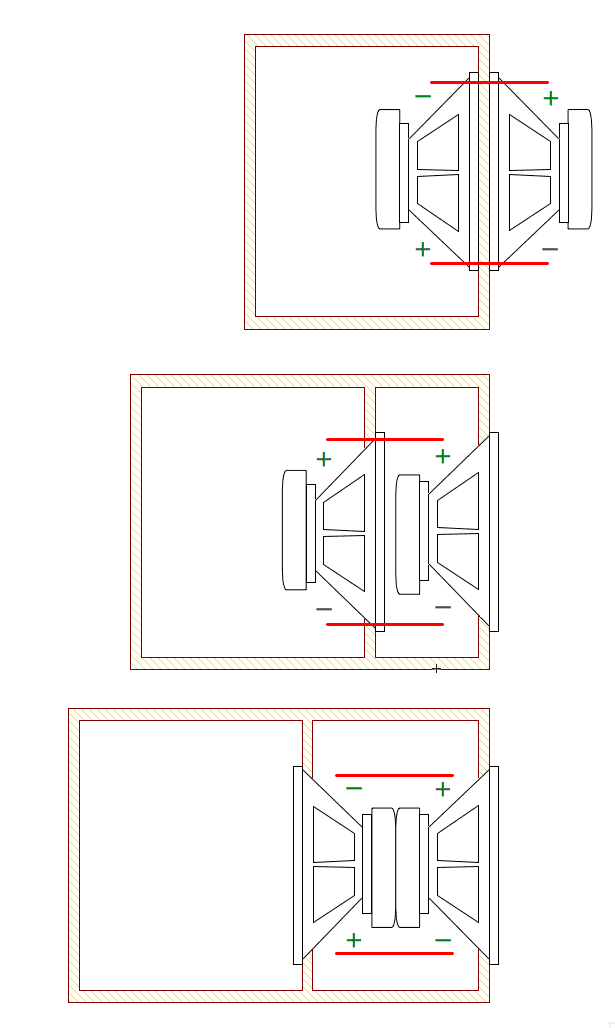
All isobarik, none push-push. The smaller the coupling chamber the better. Wiring shown.
The typical use of the terms "Push Pull" and "Push Push" is for drivers sharing a volume of air that is not enclosed, the "slot" or "plenum" or "V" shape between the two cones exits to the outside of the cabinet...
The "slot" or "plenum" or "V” shape you are talking about is just a complication. Something i have most often seen in OBs. I did a concept w visualization, Papa’s slot-loaded bass helper on an OB, the ripole.
The simpliest push-push, i posted in illustration in Post #3, (be better described as "horizontally opposed”) has the same meaning but the orientation is irrelevant.
Here a push-push, push-pull (isobarik) “torus”. Intended to have a slab of glass over the top.
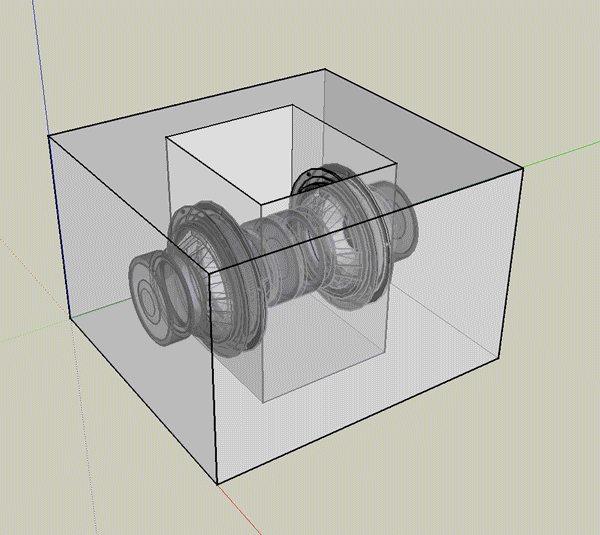
Not really enuff constriction to be considered slot loaded.
Here a more diagramatic illustration of push-pull push-push
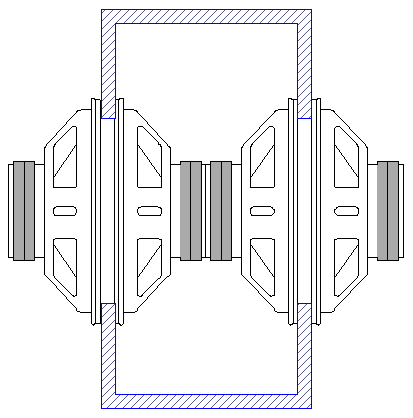
dave
It matters not in tuning how the drivers are mounted. Helmholtz did not put any restrictions on the shape of a resonator.
Let's make it simple. Cones move in-phase : Push-push
Cones move out of phase: Push-pull.
That is independent of cabinet alignment. Sealed, ported BP, IB, isobaric though usually for the tightest isobaric, they are in push-pull with cones facing to get the very smallest volume between possible. ( Art's second picture)
One can mount drivers opposing each other in one cabinet where the magnets are mechanically coupled. This is still a push push as the cones move in phase. Good design for several reasons and does not need to be as complicated as Dave's picture.
After my testing of my sealed push-pull sub, that there might be an advantage to isobaric I had not considered. That is the potential reduction in even order harmonics. Something to look into.
Let's make it simple. Cones move in-phase : Push-push
Cones move out of phase: Push-pull.
That is independent of cabinet alignment. Sealed, ported BP, IB, isobaric though usually for the tightest isobaric, they are in push-pull with cones facing to get the very smallest volume between possible. ( Art's second picture)
One can mount drivers opposing each other in one cabinet where the magnets are mechanically coupled. This is still a push push as the cones move in phase. Good design for several reasons and does not need to be as complicated as Dave's picture.
After my testing of my sealed push-pull sub, that there might be an advantage to isobaric I had not considered. That is the potential reduction in even order harmonics. Something to look into.
This!!!😱
Been a long time since i drew that.
Now we know that in a bipole you really want the width greater than the depth to reduce bipole dip.
dave
It seems there is still some confusion 🙂
Perhaps drop the terminology and think about what you want to achieve and do what's required.
Perhaps drop the terminology and think about what you want to achieve and do what's required.
You can simulate one in HornResp as an offset horn....with a sealed or rear chamber. Its not exact because it doesn't simulate 2 drivers facing each other...but you can atleast simulate one side in an accurate sized slot....and anticipate the rest.
Attachments
Last edited:
- Home
- Loudspeakers
- Subwoofers
- Definition of "push-push"
